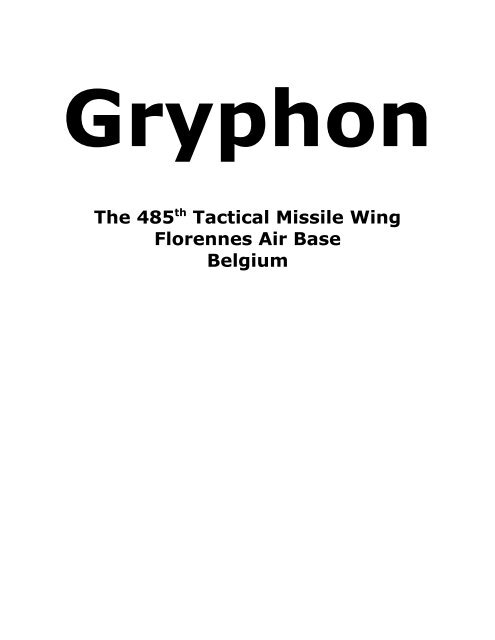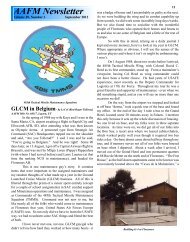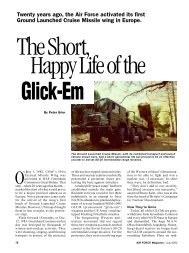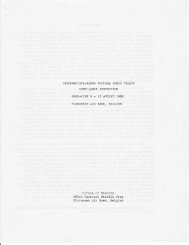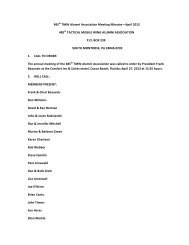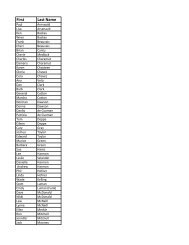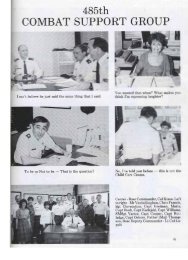The 485th Tactical Missile Wing Florennes Air Base Belgium
The 485th Tactical Missile Wing Florennes Air Base Belgium
The 485th Tactical Missile Wing Florennes Air Base Belgium
You also want an ePaper? Increase the reach of your titles
YUMPU automatically turns print PDFs into web optimized ePapers that Google loves.
Gryphon<br />
<strong>The</strong> 485 th <strong>Tactical</strong> <strong>Missile</strong> <strong>Wing</strong><br />
<strong>Florennes</strong> <strong>Air</strong> <strong>Base</strong><br />
<strong>Belgium</strong>
“My fellow Americans, I'm pleased to tell you today that I've signed legislation<br />
that will outlaw Russia forever. We begin bombing in five minutes.”<br />
- Ronald Reagan, 11 Aug 1984<br />
* * * *<br />
“Four minutes and counting.”<br />
“Ok . . .”<br />
“<strong>The</strong>y pressed the button, Jim.”<br />
“<strong>The</strong>y pressed the button, Billy? What button?”<br />
“<strong>The</strong> big red one.”<br />
“Oh, you mean THE button.”<br />
“Goodbye, Jim.”<br />
“Goodbye! Oh, yes, this ain't au revoir, it's goodbye!”<br />
- Roger Waters, Radio K.A.O.S
Chapter 1<br />
<strong>The</strong> arms race between the former Soviet Union and the United States had<br />
escalated to a point by the mid 1970s that neither side thought it could keep up<br />
with the other. <strong>The</strong> U.S. and the USSR had built their nuclear weapons<br />
inventories to such enormous levels that, in a first strike and subsequent<br />
retaliation, each side would inflict such massive devastation on the other that<br />
neither could possibly survive. In a political cartoon of the times, some generals<br />
are sitting around a conference table, and one is saying, “Did I have a nightmare<br />
last night! I dreamed they had a billion missiles and we had only a million.”<br />
Satellite mounted cameras and heat sensing arrays would detect any launch<br />
immediately, and enough warning would be given to either side to facilitate the<br />
immediate launch of a retaliatory strike. <strong>The</strong> modus operandi was Mutually<br />
Assured Destruction, or MAD. <strong>The</strong> launch of a single missile would bring about the<br />
launch of hundreds of missiles from the other side, and the escalation would be<br />
instant, exponential, and devastating in the extreme.<br />
<strong>The</strong> way to overcome such an obstacle was thought to be an updating and<br />
modernization of their armaments. This book will focus on European <strong>The</strong>ater<br />
weapons, short-range and intermediate range nuclear missiles.<br />
By building more accurate missiles, you can downsize the warhead, because a<br />
direct hit will do more damage to the target than an indirect hit. With such<br />
accuracy and a smaller warhead, an attack will do less peripheral damage and<br />
cause less unnecessary loss of civilian life. And the weapon's cost will be less,<br />
thereby loosening up funds to make even more warheads and delivery systems.<br />
Our primary European <strong>The</strong>ater weapon was the Pershing 1A missile, a two-stage<br />
rocket with a range of 100 to 400 nautical miles, a single warhead of 60-400<br />
kilotons, with a probable circular error of 1,200 feet. <strong>The</strong> Russians had an old<br />
missile, the SS-5, first deployed in 1961. It had a range of 2,000 nautical miles, a<br />
1 megaton warhead, and a probable circular error of 6000 feet.<br />
<strong>The</strong> Russians decided to upgrade their missile fleet, replacing the SS-5 with the<br />
SS-20, which had a range of 2000-2400 nautical miles, a probable circular error<br />
of 1500 feet, and 3 warheads of 1 kiloton each. In turn, the Americans would<br />
upgrade to the Pershing II, with a range of 1000-2000 nautical miles where the
1A had 100-400 mile range; a circular error probability of 120 feet, and a single<br />
1-10 kiloton warhead. While the potential collateral damage of the Soviet missile<br />
was massive in the SS-5, it was upgraded to moderate in the SS-20, and the<br />
Pershing went from moderate-extensive to very limited.<br />
To counteract the three warheads of the SS-20, the Americans developed the<br />
Ground Launched Cruise <strong>Missile</strong>, carried on a transporter, four at a time. <strong>The</strong><br />
warhead was the W84 two-stage radiation implosion bomb with a variable yield<br />
ranging from 0.2 kiloton to 150 kilotons. <strong>The</strong> GLCM was the BGM-109G Gryphon,<br />
and was capable of low level flight, basically hugging the ground and staying<br />
under radar, with a range of 1,600 miles, while flying at sub-sonic speeds of up to<br />
550 mph on a pre-determined course. It was virtually undetectable, having a<br />
F107-WR-400 turbofan engine and a solid fuel booster, leaving a miniscule launch<br />
signature.<br />
U.S. Strategy was to first launch the GLCM, then follow up with the Pershing II,<br />
which could reach its target in under 15 minutes. <strong>The</strong> missile had a radar<br />
guidance system in its nose, called the Correlatron. This system stored radar<br />
images obtained through surveillance aircraft and satellites, then compared them<br />
to real-time images, fed them into an electronic multiplier cell, which adjusted the<br />
fins on the back of the rocket and guided it in. <strong>The</strong> system was so well designed<br />
that it could be programmed to overshoot its target, thereby fooling the target's<br />
defenses, then correct its path and come back in. <strong>The</strong> missile was so fast and so<br />
accurate there was no defense against it. If this baby was launched at you, you<br />
were dead. Toast. Actually, a puff of ions floating away in the nuclear blast.<br />
By 1983, the U.S. had finalized its plan to deploy the system. In 1984, the first<br />
troops arrived at <strong>Florennes</strong> <strong>Air</strong> <strong>Base</strong>, <strong>Belgium</strong>, to get the base ready for the<br />
GLCMs. Over the next five years, the Gryphons would sit in their bunkers,<br />
awaiting the order to load up and disperse into the Ardennes forest, from where<br />
they would fly in defense of the United States and her allies. It would be an epic<br />
battle, in which millions of human beings would die. <strong>The</strong> only things that stood in<br />
the way were diplomacy, strong and unyielding leadership from the White House,<br />
the full might and power of NATO military forces led by the Americans, and the<br />
threat imposed by the missiles themselves. We were there to ensure the mission<br />
could be carried out, with full knowledge that it would likely end in our own<br />
deaths. We were willing to do the job, and we did it to perfection.<br />
This is our story.


